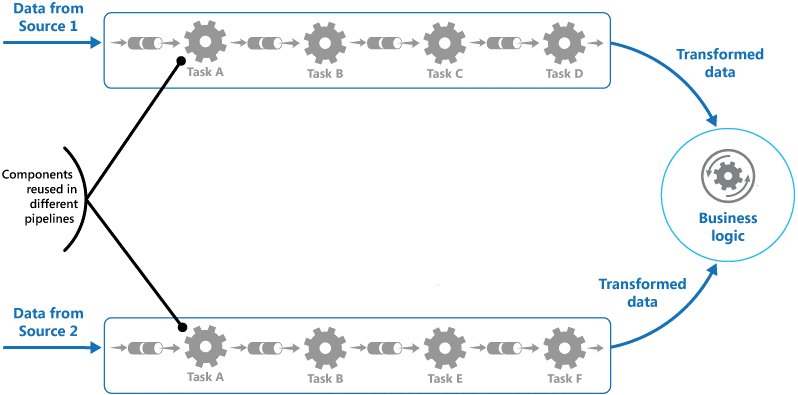An application may be required to perform a variety of tasks of varying complexity on the information that it processes. A straightforward but inflexible approach to implementing this application could be to perform this processing as monolithic module. However, this approach is likely to reduce the opportunities for refactoring the code, optimizing it, or reusing it if parts of the same processing are required elsewhere within the application.
Below illustrates the issues with processing data by using the monolithic approach. An application receives and processes data from two sources. The data from each source is processed by a separate module that performs a series of tasks to transform this data, before passing the result to the business logic of the application.

A solution implemented by using monolithic modules
Some of the tasks that the monolithic modules perform are functionally very similar, but the modules have been designed separately. The code that implements the tasks is closely coupled within a module, and this code has been developed with little or no thought given to reuse or scalability.
However, the processing tasks performed by each module, or the deployment requirements for each task, could change as business requirements are amended. Some tasks might be compute-intensive and could benefit from running on powerful hardware, while others might not require such expensive resources. Furthermore, additional processing might be required in the future, or the order in which the tasks performed by the processing could change. A solution is required that addresses these issues, and increases the possibilities for code reuse.
Decompose the processing required for each stream into a set of discrete components (or filters), each of which performs a single task. By standardizing the format of the data that each component receives and emits, these filters can be combined together into a pipeline. This helps to avoid duplicating code, and makes it easy to remove, replace, or integrate additional components if the processing requirements change. Figure 2 shows an example of this structure.

A solution implemented by using pipes and filters
The time taken to process a single request depends on the speed of the slowest filter in the pipeline. It is possible that one or more filters could prove to be a bottleneck, especially if a large number of requests appear in a stream from a particular data source. A key advantage of the pipeline structure is that it provides opportunities for running parallel instances of slow filters, enabling the system to spread the load and improve throughput.
The filters that comprise a pipeline can run on different machines, enabling them to be scaled independently and can take advantage of the elasticity that many cloud environments provide. A filter that is computationally intensive can run on high performance hardware, while other less demanding filters can be hosted on commodity (cheaper) hardware. The filters do not even have to be in the same data center or geographical location, which allows each element in a pipeline to run in an environment that is close to the resources it requires.
Below shows an example applied to the pipeline for the data from Source 1.

Load-balancing components in a pipeline
If the input and output of a filter are structured as a stream, it may be possible to perform the processing for each filter in parallel. The first filter in the pipeline can commence its work and start to emit its results, which are passed directly on to the next filter in the sequence before the first filter has completed its work.
Another benefit is the resiliency that this model can provide. If a filter fails or the machine it is running on is no longer available, the pipeline may be able to reschedule the work the filter was performing and direct this work to another instance of the component. Failure of a single filter does not necessarily result in failure of the entire pipeline.
Using the Pipes and Filters pattern in conjunction with the Compensating Transaction Pattern can provide an alternative approach to implementing distributed transactions. A distributed transaction can be broken down into separate compensable tasks, each of which can be implemented by using a filter that also implements the Compensating Transaction pattern. The filters in a pipeline can be implemented as separate hosted tasks running close to the data that they maintain.
Use this pattern when:
This pattern might not be suitable when: